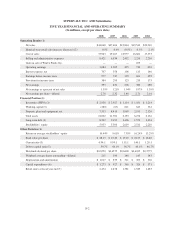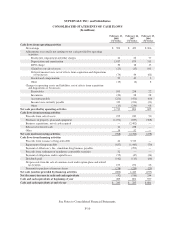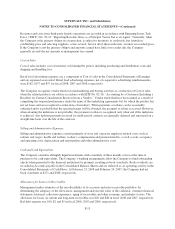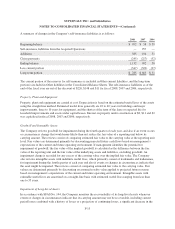Albertsons 2008 Annual Report Download - page 78
Download and view the complete annual report
Please find page 78 of the 2008 Albertsons annual report below. You can navigate through the pages in the report by either clicking on the pages listed below, or by using the keyword search tool below to find specific information within the annual report.SUPERVALU INC. and Subsidiaries
NOTES TO CONSOLIDATED FINANCIAL STATEMENTS
(Dollars and shares in millions, except per share data, unless otherwise noted)
NOTE 1—THE COMPANY AND SUMMARY OF SIGNIFICANT ACCOUNTING POLICIES
Business Description
SUPERVALU INC. (“SUPERVALU” or the “Company”), a Delaware corporation, was organized in 1925 as the
successor of two wholesale grocery firms established in the 1870’s. SUPERVALU is one of the largest
companies in the United States grocery channel. SUPERVALU conducts its retail operations throughout the
United States under three retail food store formats: combination stores (defined as food and pharmacy), food
stores and limited assortment food stores. Additionally, the Company provides supply chain services, including
wholesale distribution and related logistics support services primarily across the United States retail grocery
channel.
On June 2, 2006 (the “Acquisition Date”), the Company acquired New Albertson’s, Inc. (“New Albertsons”)
consisting of the core supermarket businesses (the “Acquired Operations”) formerly owned by Albertson’s, Inc.
(“Albertsons”).
Principles of Consolidation
The consolidated financial statements include the accounts of the Company and all majority-owned subsidiaries.
All significant intercompany accounts and transactions have been eliminated. References to the Company refer to
SUPERVALU INC. and Subsidiaries.
Fiscal Year
The Company’s fiscal year ends on the last Saturday in February. The Company’s first quarter consists of 16
weeks while the second, third and fourth quarters each consist of 12 weeks for a total of 52 weeks. Because of
differences in the accounting calendars of New Albertsons and the Company, the accompanying February 23,
2008 Consolidated Balance Sheet includes the assets and liabilities related to New Albertsons as of February 21,
2008. The accompanying Consolidated Statements of Earnings and Cash Flows for fiscal 2008 include 52 weeks
of operating results of the Acquired Operations compared to 38 weeks for fiscal 2007.
Use of Estimates
The preparation of the Company’s consolidated financial statements in conformity with accounting principles
generally accepted in the United States requires management to make estimates and assumptions that affect the
reported amounts of assets and liabilities and disclosure of contingent assets and liabilities at the date of the
financial statements and the reported amounts of revenues and expenses during the reporting period. Actual
results could differ from those estimates.
Revenue Recognition
Revenues from product sales are recognized at the point of sale for the Retail food segment and upon delivery for
the Supply chain services segment. Typically, invoicing, shipping, delivery and customer receipt of Supply chain
services product occur on the same business day. Revenues from services rendered are recognized immediately
after such services have been provided. Discounts provided to customers by the Company at the time of sale,
including those provided in connection with loyalty cards, are recognized as a reduction in net sales as the
products are sold. Sales tax is excluded from net sales.
F-12
























